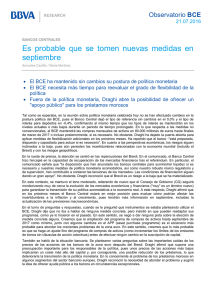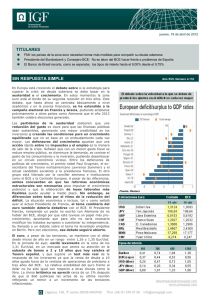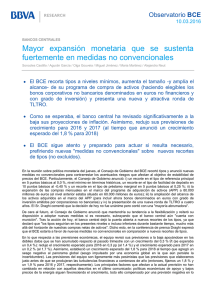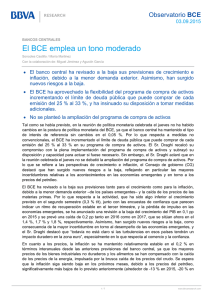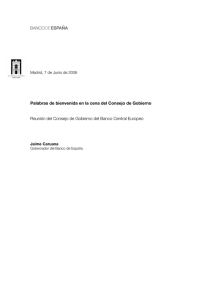CENTRAL BANKS - BBVA Research
Anuncio
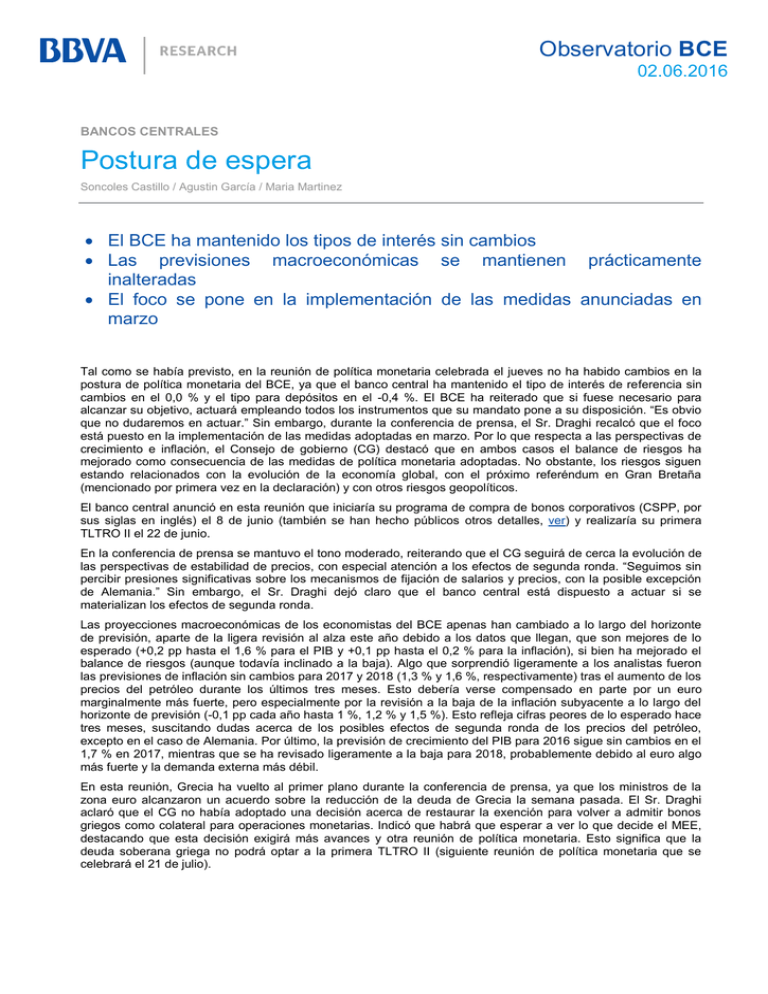
Observatorio BCE 02.06.2016 BANCOS CENTRALES Postura de espera Soncoles Castillo / Agustin García / Maria Martinez El BCE ha mantenido los tipos de interés sin cambios Las previsiones macroeconómicas se mantienen prácticamente inalteradas El foco se pone en la implementación de las medidas anunciadas en marzo Tal como se había previsto, en la reunión de política monetaria celebrada el jueves no ha habido cambios en la postura de política monetaria del BCE, ya que el banco central ha mantenido el tipo de interés de referencia sin cambios en el 0,0 % y el tipo para depósitos en el -0,4 %. El BCE ha reiterado que si fuese necesario para alcanzar su objetivo, actuará empleando todos los instrumentos que su mandato pone a su disposición. “Es obvio que no dudaremos en actuar.” Sin embargo, durante la conferencia de prensa, el Sr. Draghi recalcó que el foco está puesto en la implementación de las medidas adoptadas en marzo. Por lo que respecta a las perspectivas de crecimiento e inflación, el Consejo de gobierno (CG) destacó que en ambos casos el balance de riesgos ha mejorado como consecuencia de las medidas de política monetaria adoptadas. No obstante, los riesgos siguen estando relacionados con la evolución de la economía global, con el próximo referéndum en Gran Bretaña (mencionado por primera vez en la declaración) y con otros riesgos geopolíticos. El banco central anunció en esta reunión que iniciaría su programa de compra de bonos corporativos (CSPP, por sus siglas en inglés) el 8 de junio (también se han hecho públicos otros detalles, ver) y realizaría su primera TLTRO II el 22 de junio. En la conferencia de prensa se mantuvo el tono moderado, reiterando que el CG seguirá de cerca la evolución de las perspectivas de estabilidad de precios, con especial atención a los efectos de segunda ronda. “Seguimos sin percibir presiones significativas sobre los mecanismos de fijación de salarios y precios, con la posible excepción de Alemania.” Sin embargo, el Sr. Draghi dejó claro que el banco central está dispuesto a actuar si se materializan los efectos de segunda ronda. Las proyecciones macroeconómicas de los economistas del BCE apenas han cambiado a lo largo del horizonte de previsión, aparte de la ligera revisión al alza este año debido a los datos que llegan, que son mejores de lo esperado (+0,2 pp hasta el 1,6 % para el PIB y +0,1 pp hasta el 0,2 % para la inflación), si bien ha mejorado el balance de riesgos (aunque todavía inclinado a la baja). Algo que sorprendió ligeramente a los analistas fueron las previsiones de inflación sin cambios para 2017 y 2018 (1,3 % y 1,6 %, respectivamente) tras el aumento de los precios del petróleo durante los últimos tres meses. Esto debería verse compensado en parte por un euro marginalmente más fuerte, pero especialmente por la revisión a la baja de la inflación subyacente a lo largo del horizonte de previsión (-0,1 pp cada año hasta 1 %, 1,2 % y 1,5 %). Esto refleja cifras peores de lo esperado hace tres meses, suscitando dudas acerca de los posibles efectos de segunda ronda de los precios del petróleo, excepto en el caso de Alemania. Por último, la previsión de crecimiento del PIB para 2016 sigue sin cambios en el 1,7 % en 2017, mientras que se ha revisado ligeramente a la baja para 2018, probablemente debido al euro algo más fuerte y la demanda externa más débil. En esta reunión, Grecia ha vuelto al primer plano durante la conferencia de prensa, ya que los ministros de la zona euro alcanzaron un acuerdo sobre la reducción de la deuda de Grecia la semana pasada. El Sr. Draghi aclaró que el CG no había adoptado una decisión acerca de restaurar la exención para volver a admitir bonos griegos como colateral para operaciones monetarias. Indicó que habrá que esperar a ver lo que decide el MEE, destacando que esta decisión exigirá más avances y otra reunión de política monetaria. Esto significa que la deuda soberana griega no podrá optar a la primera TLTRO II (siguiente reunión de política monetaria que se celebrará el 21 de julio). Observatorio BCE 02.06.2016 Respecto al próximo referéndum sobre el Brexit, el Sr. Draghi manifestó que el Reino Unido y la zona euro “se benefician mutuamente”, destacando que el Reino Unido debe permanecer en la Unión Europea. Sobre la cuestión de si el BCE está preparado para asumir cualquier resultado, el Sr. Draghi señaló que el BCE está preparado para cualquier contingencia. Tal como se esperaba, en la reunión celebrada hoy el Sr. Draghi confirmó el compromiso del BCE de mantener una trayectoria de política monetaria estable. Esperamos que el BCE se mantenga a la espera, siguiendo de cerca el impacto de las medidas anunciadas en marzo. Observatorio BCE 02.06.2016 DESTACADO: sobre el formato del comunicado del BCE: El aparente formato “control de cambios” que se emplea a continuación tiene por objeto facilitar el seguimiento de cambios del comunicado respecto a la anterior reunión del BCE. En negro aparece la parte del comunicado que se mantiene sin cambios. En azul y subrayado las novedades de la última reunión y en rojo y tachado, el texto que no aparece en el nuevo comunicado Mario Draghi, President of the ECB, Vítor Constâncio, Vice-President of the ECB, Frankfurt am Main, 21 AprilVienna, 2 June 2016 Ladies and gentlemen, the Vice-President and I are very pleased to welcome you to our press conference. We will now report on the outcome of I would like to thank Governor Nowotny for his kind hospitality and express our special gratitude to his staff for the excellent organisation of today’s meeting of the Governing Council, which was also attended by the Commission Vice-President, Mr Dombrovskis. We will now report on the outcome of our meeting. Based on our regular economic and monetary analyses, we decided to keep the key ECB interest rates unchanged. We continue to expect them to remain at present or lower levels for an extended period of time, and well past the horizon of our net asset purchases. Regarding non-standard monetary policy measures, as decided on 10 March 2016, we have started to expand our confirm that the monthly asset purchases under the asset purchase programme to €of €80 billion, from the previous amount of €60 billion. As stated before, these purchases are intended to run until the end of March 2017, or beyond, if necessary, and in any case until the Governing Council sees a sustained adjustment in the path of inflation consistent with its inflation aim. As a next step, on 8 June we will start making purchases under our corporate sector purchase programme (CSPP). Moreover, instarting on 22 June, we will conduct the first operation ofin our new series of targeted longer-term refinancing operations (TLTRO II) and we will commence purchases under our corporate sector purchase programme (CSPP). . Further information on the implementation aspects of the CSPP will be released after the press conference on the ECB’s website. Following ourThe comprehensive package of decisions taken in early March, broad financing conditions in the euro area have improved. The pass-through of the monetary policy stimulus to firms and households, notably through the banking system, is strengthening. However, global uncertainties persist. Looking forward, it is essential to preserve an appropriate degree of monetary accommodation as long as needed in order to underpin underpins the momentum of the euro area’s economic recovery and in order to acceleratefosters the return of inflation to levels below, but close to, 2%. The Governing Council will In particular, Observatorio BCE 02.06.2016 our measures continue to monitor closelyease the cost of credit and contribute to a strengthening in credit creation. The economic recovery is gradually proceeding. Additional stimulus, beyond the impetus already taken into account, is expected from the monetary policy measures still to be implemented and will contribute to further rebalancing the evolution ofrisks to the outlook for price stability and, if warranted to achieve its objective, will act by using all the instruments available within its mandategrowth and inflation. In the current context, it is crucial to ensure that the very low inflation environment does not become entrenched in second-round effects on wage and price setting. The Governing Council will closely monitor the evolution of the outlook for price stability and, if warranted to achieve its objective, will act by using all the instruments available within its mandate. Let me now explain our assessment in greater detail, starting with the economic analysis. Euro area real GDP increased by 0.35%, quarter on quarter, in the fourthfirst quarter of 2016, after 0.3% in the last quarter of 2015,. Growth continues to be supported by domestic demand, while being dampened by relatively weak export trends. Incomingexports. The latest data for the first quarter of 2016 point to ongoing output growth, at a pace broadly similar to that in the finalsecond quarter of 2015., though possibly at a lower rate than in the first quarter. Looking ahead, we expect the economic recovery to proceed. at a moderate but steady pace. Domestic demand, in particular, continues to be remains supported by the pass-through of our monetary policy measures. Their favourable impact on to the real economy. Favourable financing conditions, together with and improvements in corporate profitability, is benefiting continue to promote investment. Moreover, our accommodative monetary policy stance, continuedsustained employment gains resulting , which are also benefiting from past structural reforms, and the still relatively low price of oil shouldprices provide ongoingadditional support for households’ real disposable income and private consumption. In addition, the fiscal stance in the euro area is slightly expansionary. At the same timeHowever, the economic recovery in the euro area is stillcontinues to be dampened by the ongoingsubdued growth prospects in emerging markets, the necessary balance sheet adjustments in a number of sectors, the insufficient and a sluggish pace of implementation of structural reforms and subdued growth prospects in emerging markets. This outlook is broadly reflected in the June 2016 Eurosystem staff macroeconomic projections for the euro area, which foresee annual real GDP increasing by 1.6% in 2016 and 1.7% in 2017 and 2018. Compared with the March 2016 ECB staff macroeconomic projections, the outlook for real GDP growth has been revised up for 2016 and has remained broadly unchanged for 2017 and 2018. The risks to the euro area growth outlook still remain tilted to the downside. Our recent, but the balance of risks has improved on the back of the monetary policy decisions have improved overall financing conditions, which should support the outlook for consumption and investment. However, uncertainties persist and measures taken and the stimulus still in the pipeline. Downside risks continue to relate, in particular, to developments in the global economy, to the upcoming British referendum and to other geopolitical risks. According to EurostatEurostat’s flash estimate, euro area annual HICP inflation in MarchMay 2016 was -0.0%, compared with 1%, up from -0.2% in February, April, mainly reflecting mainly a rise inhigher energy and services price inflation. Looking ahead, on the basis of current futures prices for energyoil, inflation rates could turnare likely to remain very low or negative again in the comingnext few months before picking up in the second half of 2016. Observatorio BCE 02.06.2016 Thereafter, supported, in large part owing to base effects in the annual rate of change of energy prices. Supported by our monetary policy measures and the expected economic recovery, inflation rates should recover further in 2017 and 2018. This broad pattern is also reflected in the June 2016 Eurosystem staff macroeconomic projections for the euro area, which foresee annual HICP inflation at 0.2% in 2016, 1.3% in 2017 and 1.6% in 2018. In comparison with the March 2016 ECB staff macroeconomic projections, the outlook for HICP inflation has been revised slightly up for 2016, reflecting recent oil price increases, and has remained unchanged for 2017 and 2018. Turning to the monetary analysis, broad money (M3) continued to grow at a robust pace in FebruaryApril 2016, with its annual rate of growth remaining unchangedstanding at 4.6%, after 5.0%.% in March. As in previous months, annual growth in M3 is mainly supported by its most liquid components, with the narrow monetary aggregate M1 growing at an annual rate of 10.39.7% in FebruaryApril, after 10.51% in JanuaryMarch. Loan dynamics followed the path of gradual recovery observed since the beginning of 2014. The annual rate of change of loans to non-financial corporations (adjusted for loan sales and securitisation) increased to 0.9stood at 1.2% in FebruaryApril 2016, up from 0.6compared with 1.1% in JanuaryMarch. Developments in loans to enterprises continue to reflect the lagged relationship with the business cycle, credit risk and the ongoing adjustment of financial and non-financial sector balance sheets. The annual growth rate of loans to households (adjusted for loan sales and securitisation) increased toremained broadly stable at 1.5% in April, after 1.6% in February 2016, from 1.4% in JanuaryMarch. The euro area bank lending survey for the first quarter of 2016 indicates further improvements in loan supply conditions for enterprises and in loan demand across all loan categories. Improvements in the demand for bank loans were supported by the low level of interest rates, financing needs for investment purposes and housing market prospects. Overall, theThe monetary policy measures in place since June 2014 have clearly improved borrowing conditions for firms and households, as well as credit flows across the euro area. The comprehensive package of new monetary policy measures adopted in March this year underpins the ongoing upturn in loan growth, thereby supporting the recovery of the real economy. To sum up, a cross-check of the outcome of the economic analysis with the signals coming from the monetary analysis confirmed the need to preserve an appropriate degree of monetary accommodation in order to secure a return of inflation rates towards levels that are below, but close to, 2% without undue delay. Monetary policy is focused on maintaining price stability over the medium term and its accommodative stance supports economic activity. As emphasised repeatedly by the Governing Council, and as again strongly echoed in both European and international policy discussions, in order to reap the full benefits from our monetary policy measures, other policy areas must contribute much more decisively, both at the national and at the European levels. Structural policies are essential, given continued high structural unemployment and low potential output growth in the euro area. In particular,Structural reforms are necessary in all euro area countries, although specific reform needs differ across the individual economies. At this stage, the focus should be on actions to raise Observatorio BCE 02.06.2016 productivity and improve the business environment, including the provision of an adequate public infrastructure, which are vital to increase investment and boost job creation. TheThe enhancement of current investment initiatives, including the extension of the Juncker plan, and progress on the capital markets union will also contribute positively to this objective. In an environment of accommodative monetary policy, the swift and effective implementation of structural reforms, in an environment of accommodative monetary policyline with the countryspecific recommendations recently published by the European Commission, will not only lead to higher sustainable economic growth in the euro area but will also make the euro area more resilient to global shocks. Fiscal policies should also support the economic recovery, while remaining in compliance with the fiscal rules of the European Union. Full and consistent implementation of the Stability and Growth Pact over time and across countries is crucial to maintain confidence in the fiscal framework. At the same time, all countries should strive for a more growth-friendly composition of fiscal policies. Observatorio BCE 02.06.2016 AVISO LEGAL El presente documento, elaborado por el Departamento de BBVA Research, tiene carácter divulgativo y contiene datos, opiniones o estimaciones referidas a la fecha del mismo, de elaboración propia o procedentes o basadas en fuentes que consideramos fiables, sin que hayan sido objeto de verificación independiente por BBVA. BBVA, por tanto, no ofrece garantía, expresa o implícita, en cuanto a su precisión, integridad o corrección. Las estimaciones que este documento puede contener han sido realizadas conforme a metodologías generalmente aceptadas y deben tomarse como tales, es decir, como previsiones o proyecciones. La evolución histórica de las variables económicas (positiva o negativa) no garantiza una evolución equivalente en el futuro. El contenido de este documento está sujeto a cambios sin previo aviso en función, por ejemplo, del contexto económico o las fluctuaciones del mercado. BBVA no asume compromiso alguno de actualizar dicho contenido o comunicar esos cambios. BBVA no asume responsabilidad alguna por cualquier pérdida, directa o indirecta, que pudiera resultar del uso de este documento o de su contenido. Ni el presente documento, ni su contenido, constituyen una oferta, invitación o solicitud para adquirir, desinvertir u obtener interés alguno en activos o instrumentos financieros, ni pueden servir de base para ningún contrato, compromiso o decisión de ningún tipo. Especialmente en lo que se refiere a la inversión en activos financieros que pudieran estar relacionados con las variables económicas que este documento puede desarrollar, los lectores deben ser conscientes de que en ningún caso deben tomar este documento como base para tomar sus decisiones de inversión y que las personas o entidades que potencialmente les puedan ofrecer productos de inversión serán las obligadas legalmente a proporcionarles toda la información que necesiten para esta toma de decisión. El contenido del presente documento está protegido por la legislación de propiedad intelectual. Queda expresamente prohibida su reproducción, transformación, distribución, comunicación pública, puesta a disposición, extracción, reutilización, reenvío o la utilización de cualquier naturaleza, por cualquier medio o procedimiento, salvo en los casos en que esté legalmente permitido o sea autorizado expresamente por BBVA.
